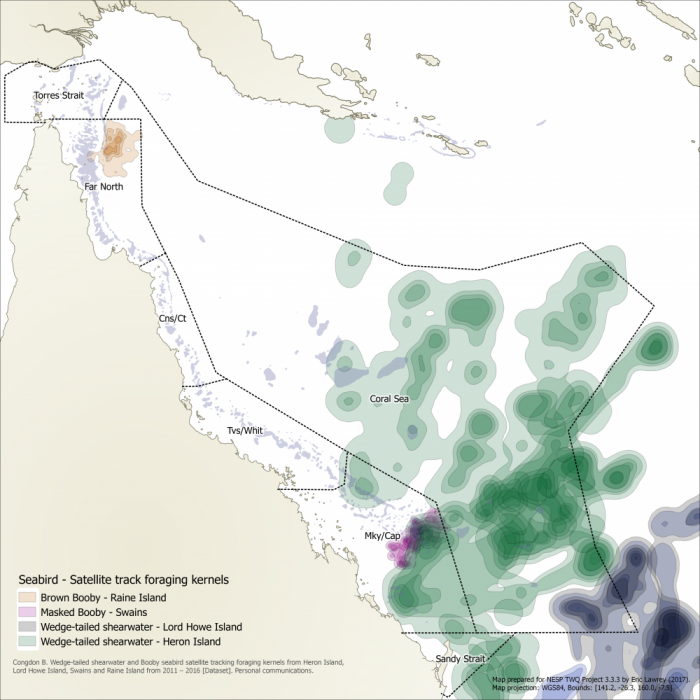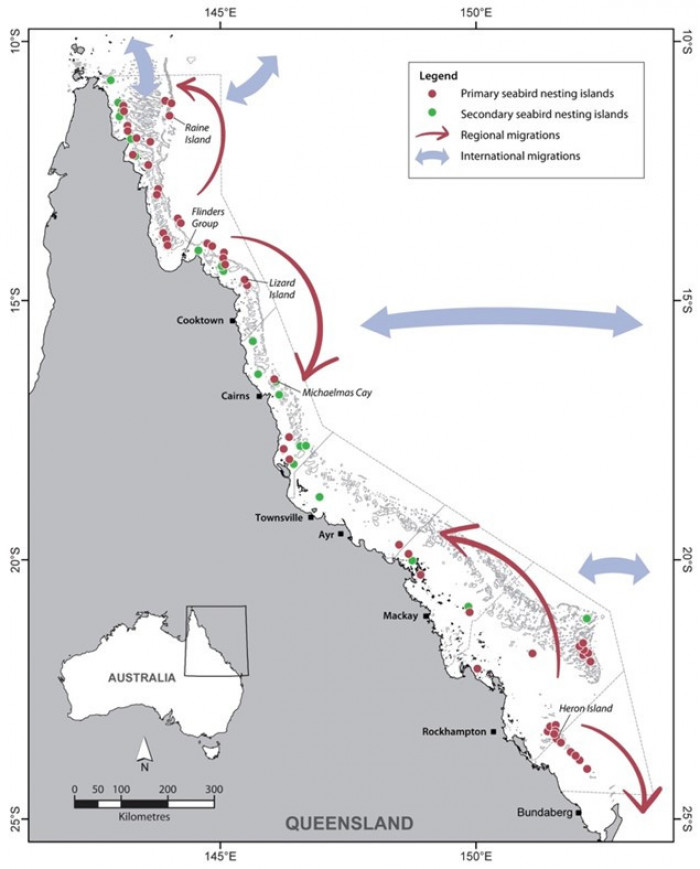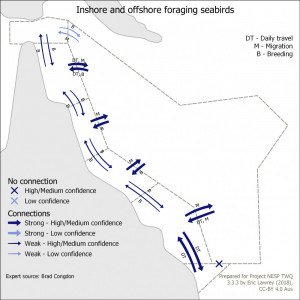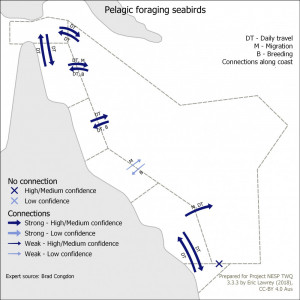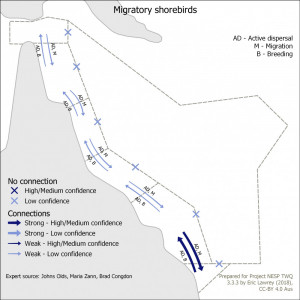Seabirds and shorebirds connectivity

Introduction to seabirds and shorebirds and why they are important
Seabirds are highly visible, charismatic predators in marine ecosystems that are defined as feeding exclusively at sea, in either nearshore, offshore or pelagic waters. Seabirds play a number of important functional roles in marine ecosystems, including the transfer of nutrients from offshore and pelagic areas to islands and reefs, seed dispersal and the distribution of organic matter into lower parts of the developing soil profile (e.g. burrow-nesting species such as shearwaters). The northeast Australian seascape is of international importance to seabirds, providing breeding and roosting habitat, feeding grounds and migratory pathways for about 23 seabird species and 32 shorebird species (Hulsman et al. 1996). It is estimated that between 1.3 and 1.7 million birds breed on the region’s islands and cays each year, comprising over 25% of Australia’s breeding seabird populations, and approximately 50% of the global population for some species (Congdon 2018).
Figure 2. This map shows the currently known foraging habitat use of Brown booby (light brown, Raine Island breeding population), Masked booby (dark pink, Swains Reefs breeding population) and Wedge-tailed shearwater (green, Heron Island breeding population; purple Lord Howe Island breeding population) in the northeast Australian seascape. It was developed using data from satellite (PTT) and GPS foraging track analyses. Darker colours indicate more intensive use by multiple individuals.. Source: B. Congdon, F. McDuie, M. Miller.
Key concepts that relate to connectivity
Seabird and shorebird populations vary between sites and years depending on migration patterns, environmental conditions and the general condition of the populations. While some breeding populations may be quite isolated from each other behaviourally, most seabird species migrate large distances to access resources (McDuie et al. 2015, 2018; see Figures 3 and 4) resulting in high connectivity of seabirds and shorebirds (see Figures 5a-c). Therefore, activities in distant locations – both within Australia and internationally – can have significant consequences for populations in northeast Australia. Seabirds are one of the most threatened groups of animals globally. Population declines are driven by bycatch mortality (for some species), competition with fisheries and anthropogenic impacts at nesting sites, with climate change and plastics pollution emerging issues.
Long- and short-term data sets show that there are significant negative impacts of climate driven changes in oceanography on the breeding success of multiple seabird species that occur throughout the northeast Australian seascape (Chambers et al. 2009, 2011, Devney et al. 2009, 2010). These relationships suggest predicted ongoing changes in climate are going to be significantly detrimental to breeding seabirds. Due to this large-scale globally driven threat, ongoing seabird management efforts need to continue to address local stressors, so as to offset factors impacting beyond management boundaries. This includes island impacts at breeding colonies, such as human disturbances and habitat destruction, invasive species, predators, pathogens, and pollution (plastics, oil, organics).
In addition, much seabird foraging activity and the resources they use are either in inter-reefal open waters or outside current GBR management boundaries in pelagic waters (McDuie and Congdon 2016, McDuie et al. 2015, 2018). So management also needs to be concerned with impacts on foraging resources at-sea as well as impacts at breeding colonies. Breeding success (for some species at least) has also been linked to facilitated foraging with subsurface predators such as tuna and billfish (Miller et al. 2018). For species where facilitated foraging with subsurface predators is important, interactions can occur with large-scale commercial fisheries, and therefore seabird conservation activities and fisheries management need to be integrated and coordinated to achieve effective seabird outcomes.
References and Further Reading
Chambers, L.E., Congdon, B.C., Dunlop, N., Dann, P., Devney, C. (2009) Seabirds and climate change. Marine Climate Change in Australia: Impacts and Adaptation Responses.
Chambers, L.E, Devney, C.A., Congdon, B.C., Dunlop, N., Woehler, E.J., Dann, P. (2011) Observed and predicted impacts of climate on Australian seabirds. Emu-Austral Ornithology, 111(3): 235-251
Congdon, B.C. (2018) Seabirds. In: Hutchins, P., Kingsford, M., Hoegh-Guldberg, O. (Eds.) The Great Barrier Reef: Biology, Environment and Management (2nd Edition) CSIRO publishing, Australia.
Congdon, B.C., Erwin, C.A., Peck, D.R., Baker, G.B., Double, M.C., O’Neill, P. (2007) Vulnerability of seabirds on the Great Barrier Reef to climate change In: Johnson J. & Marshall P. (Eds) Climate change and the Great Barrier Reef. Great Barrier Reef Marine Park Authority, Canberra.
Devney, C.A., Short, M., Congdon, B.C. (2009) Sensitivity of tropical seabirds to El Niño precursors Ecology, 90: 1175-1183, ISSN 0012-9658, doi.org/10.1890/08-0634.1, (if 5.07)
Devney, C.A., Short, M., Congdon, B.C. (2009) Cyclonic and anthropogenic influences on terns breeding at Michaelmas Cay, Great Barrier Reef, Australia Wildlife Research, 36: 368-378, ISSN 1035-3712
Devney, C.A., Caley, M.J., Congdon, B.C. (2010) Plasticity of noddy parents and offspring to sea-surface temperature anomalies PLoS ONE, 5(7): e11891.
GBRMPA [Great Barrier Reef Marine Park Authority] (2008) Seabirds and shorebirds in the Great Barrier Reef World Heritage Area in a changing climate [electronic resource]: a workshop report. C&R Consulting, 44pp.
Hulsman, K., O’Neill, P., Stokes, T. (1996) Current status and trends of seabirds on the Great Barrier Reef. In: Anon (ed.) The Great Barrier Reef: Science, Use and Management. Great Barrier Reef Marine Park Authority, Townsville, 259–282.
McDuie, F., Congdon, B.C. (2016) Trans-equatorial migration and non-breeding habitat of tropical shearwaters: implications for modelling pelagic Important Bird Areas. Marine Ecology Progress Series, 550: 219-234
McDuie, F., Weeks, S.J., Miller, M.G.R., Congdon, B.C. (2015) Breeding tropical shearwaters use ‘at-distance’ foraging sites when self-provisioning. Marine Ornithology, 43: 123-129
McDuie, F., Weeks, S., Congdon, B.C. (2018) Oceanographic drivers of near-colony foraging site use in tropical marine systems. Marine Ecology Progress Series, 589: 209-255 DOI:10.3354/meps12475
Miller, M.G.R., Carlile, N., Phillips, J.S., McDuie, F., Congdon, B.C. (2018) The importance of tropical tuna for seabirds foraging over a marine productivity gradient. Marine Ecology Progress Series, 586: 233-249 DOI:https://doi.org/10.3354/meps12376
Miller, M.G.R, Silva, F.R.O., Macovsky-Capuska, G.E., Congdon, B.C. (2018) Sexual segregation in tropical seabirds: drivers of sex-specific foraging in the Brown Booby Sula leucogaster. Journal of Ornithology, 159: 425-437 https://doi.org/10.1007/s10336-017-1512-1
Weeks S. J., Steinberg, C., Congdon, B.C. (2013). Oceanography and seabird foraging: within-season impacts of increasing sea surface temperature on the Great Barrier Reef. Marine Ecology Progress Series, 490: 247-254




